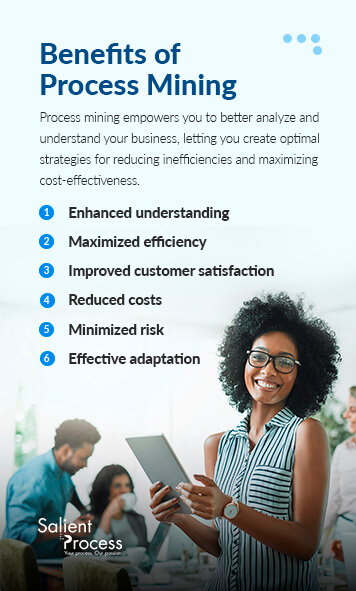
Modern technology’s integration with globalization has made markets more competitive than ever. Businesses need to remain on the cutting edge so they can maximize cost-effectiveness, efficiency, and customer satisfaction. With ever-evolving technology and global interconnectedness heightening competition, you must optimize your business for better market success. Employing data-driven solutions allows you to analyze all aspects of your organization and develop solutions tailored to your unique needs.
Process mining gives you direct insight into your internal processes. Every business is built on processes — these strategies help you meet goals around products, supplies, deliveries, and more. While all of these factors combine to influence your key metrics, process mining lets you analyze them individually. By breaking down each component, you can fix each inefficiency at the source for a better, more optimized whole.
Understanding how process mining works and how it can benefit your business gives you more control over your processes and allows you to develop structures and strategies that meet your goals. Better operation and increased goal success put you ahead of the competition without excessive spending and resource loss. Explore process mining and how it can make your company more effective through automation.
Process mining uses sophisticated technology to analyze and optimize your business processes. As your business changes, your processes need to expand and keep pace with that growth. Process mining examines your existing business processes to find the most efficient operations methods. The sophistication of process mining allows you to receive customized solutions for each business process, optimizing your business as a whole by streamlining each individual part.

Process mining software compiles data from your information systems. Process mining can uncover inefficiencies in your current processes by modeling and analyzing this data. The combination of data mining and analytics provides unique insight into your operations. With your process mining analyses, you can close gaps and waste, streamlining your business and making it more efficient than ever.
Process mining tools take data from your systems and analyze factors like tasks, task length, and who performed a task to develop patterns. After examining these resources, the software sorts patterns from deviations. These deviations are points of inefficiency — areas like bottlenecks where something is preventing the process from operating as efficiently as possible. Once you have concrete, data-focused analysis, you can begin implementing solutions like automation to customize optimized operations for each process.
Tailoring process mining to your unique needs allows you to receive the most custom, effective solutions. However, you can use these broad steps to understand how process mining is completed:
The first step in any process mining job is compiling data. Most companies use different applications to track and store data related to their processes — delays, expected deliveries, supplies, and more are all saved and stored. Process mining needs all relevant data and event logs to create the most accurate analysis possible. Process mining technology takes in relevant event logs and uses that data to process and analyze your business.
After receiving all relevant data, processing begins. The process mining software analyzes all the log data, turning it into a chronological sequence for better optimization. These sequence analyses are called end-to-end visualization. Organizing data into this visualization pattern allows the software to lay out each step of the process, building a story that’s easy to follow. Once end-to-end visualization is completed, you can look at each process step to pinpoint bottlenecks, gaps, and inefficiencies.

Once all data is processed, the software analyzes and catalogs any inefficiencies it finds during data processing and analysis. Process mining lays out missed deadlines, late times, and untapped resources, allowing you to see the exact points in your process that could be tweaked. Once you’ve spotted these inefficiencies, you can uncover their root causes. Since inefficiencies spread to other metrics and reduce overall productivity, being able to find these causes with process mining can help drastically improve your operation.
Comparison is an extremely helpful step used during data mining. Process comparison allows you to use process mining to evaluate outcomes based on unique input situations. You can model how a different supplier, cost-reduction method, or workforce change will affect your business. Using modeling lets you explore other options without using real-life resources and time to determine how these options will benefit or harm each process. This comparison allows you to test out cost-effective options in a risk-free environment.
Process conformance is another step you can use to check your efficiency. This part of the process mining routine lets you set your process against a preferred process method. The software will tell you how your current process follows this method and where it deviates from the optimized method. The deviations highlight where your process might take too long, skip steps, or underutilize resources. Once you’ve pinpointed your variations, you can explore how others altered their procedures and how these changes affected their processes for better efficiency.
The final component of any process mining is improvement planning. After inputting and analyzing all your data, you can begin taking steps to improve your processes. Once you know where your inefficiencies are, you and your team can start developing new strategies to combat them. If you have specific goals you’re looking to meet, you can begin planning to cut these inefficiencies down. You can improve your operation more effectively with all the relevant data and analyses from process mining.
Data mining is used to analyze broad sectors for patterns, while process mining focuses on answering why a business process works the way it does. Since data mining looks for trends to help with predictions and discovery, it draws from large data sets like databases and uses machine learning and artificial intelligence to draw conclusions. Process mining takes data from a business’s event logs and suggests inefficiencies and solutions based on your business’s processes.
Data mining looks at the what of a data set — what patterns exist and what we can predict based on those patterns. Process mining is similar to data mining — both compile data to analyze trends — but process mining focuses on a business’ processes and how they work to get the end efficiency results. Process mining gives you the ‘why’of a process to help you pinpoint improvement areas. It is focused on finding process points that can be optimized to improve your process performance. You might compile data to find out where bottlenecks are and test solutions for eliminating them.
Process mining can offer a wide range of benefits to businesses across all industries. Using event logs and analyzing your process data gives you deeper insight into your organization than ever before. Process mining empowers you to better analyze and understand your business, letting you create optimal strategies for reducing inefficiencies and maximizing cost-effectiveness. Here are some of the significant benefits process mining offers your business:

Most businesses can benefit from process mining. Companies can solve complex problems efficiently and optimize their operations with process mining’s analytical capabilities. Processes that deal with logistics, customer satisfaction, and financial goals benefit the most from process mining. With their data-focused areas, they can use process mining to its fullest extent. These groups are constantly looking for solutions to their ever-changing needs.
Process mining allows these divisions to adapt as needed to their evolving goals:
Salient Process is the solution to your process mining needs. As an industry leader in workplace automation solutions, we have the experience and tools needed to keep your costs low while optimizing production. Our customized solutions optimize organization efficiency for better, more adaptable solutions. We help you reduce manual data strain and put the focus back on customers, letting you meet your goals and prioritize quality.
Process mining is just one of our cutting-edge automation solutions for businesses. Working with Salient’s automation offerings enables you to reduce employee workload, reduce risk, and develop a more productive operation. As an IBM Premier Business Partner, you can trust our expert team to deliver unmatched solutions, results, and expertise for your business. You’ll work closely with us to develop the goals and processes essential for maximizing your company’s potential.
If you’re looking for optimized, industry-leading solutions and tools, contact us online to learn more today.